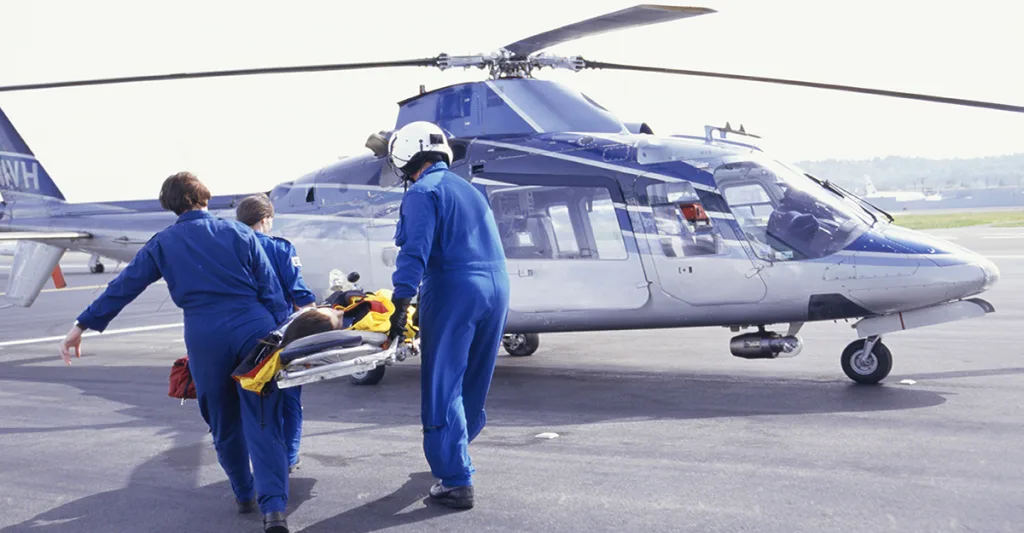A flight nurse for 28 years, Allen C. Wolfe Jr., MSN, CNS, APRN, CFRN, still feels the adrenaline rush during a rescue that he felt when he first touched down as a flight nurse decades ago.
[caption id="attachment_77357" align="alignleft" width="250"] Allen Wolfe, APRN[/caption] The vast skill set, knowledge base, teamwork, and quick and creative thinking all come into play during flight nursing in the spurt of time when the aircraft lands to safely transport a patient for life-saving treatment. "A flight nurse has to be a little bit of an expert in everything," said Wolfe, senior director of clinical education at Life Link III in Denver, Colo. "And you have to be able to turn on and turn off in spurts, meaning you are stationed like a firefighter -- you sit at a base and wait for a call. That call could be something minor or something pretty disastrous, even something that's beyond your thoughts like the Pentagon attack (on 9/11)." For Wolfe, one of the highlights of flight nursing is that it offers nurses autonomy. Flight nurses are trained to act much like a nurse practitioner or physician assistant in the emergency department, he said.
Allen Wolfe, APRN[/caption] The vast skill set, knowledge base, teamwork, and quick and creative thinking all come into play during flight nursing in the spurt of time when the aircraft lands to safely transport a patient for life-saving treatment. "A flight nurse has to be a little bit of an expert in everything," said Wolfe, senior director of clinical education at Life Link III in Denver, Colo. "And you have to be able to turn on and turn off in spurts, meaning you are stationed like a firefighter -- you sit at a base and wait for a call. That call could be something minor or something pretty disastrous, even something that's beyond your thoughts like the Pentagon attack (on 9/11)." For Wolfe, one of the highlights of flight nursing is that it offers nurses autonomy. Flight nurses are trained to act much like a nurse practitioner or physician assistant in the emergency department, he said.
"With having those skills comes great responsibility," Wolfe said. "When you get out of the aircraft and open that ambulance or you go to that scene, you have literally no idea what you're getting. It could be someone who rolled over in a car four or five times. It could be someone who was impaled by an object."
As the number of rural hospital closings increases, air medical transport connects patients in rural America to quality care. That includes patients who have strokes or heart attacks and are hours away from the nearest hospital or specialized care center. Flight nurses become busier than usual when COVID-19 cases spike, according to a U.S. News and World Report article. Air medical teams caring for patients in the Navajo Nation in Arizona, for example, are working 48-hour shifts to provide critically ill coronavirus patients with care they'd normally receive in a traditional hospital ICU, including placing them on ventilators en route to hospitals. "Healthcare facilities are available within the Navajo Nation but they're not sufficient to meet all the needs of severely ill COVID-19 patients," said flight nurse Kim Fawcett in the article. "While a few facilities on the reservation have small ICUs, they can't offer specialized critical care," according to flight nurse Kim Fawcett, who was interviewed for the article. "So we transfer them to a higher level of care."
The Aircraft ICU Setting
In general, U.S. air medical programs deploy teams including a pilot, nurse, and paramedic. Some use two nurses and still others might use a nurse and a medical resident, but those are less common. The planes or helicopters carry a cot or stretcher that can accommodate one or two people (depending on the aircraft's size), a monitor, medications, a defibrillator, and a ventilator. Basically, all the tools one would need to take care of a patient from point A to point B, which is the goal for air medical, according to Wolfe. "You sit with your flight suit and a helmet on," Wolfe said. "At night you have night vision goggles attached to your helmet. It's a confined space. For nurses who can work in that, great."
Who Makes a Good Candidate for Flight Nursing?
Nurses who want to become flight nurses need emergency room or critical care experience. Most programs require a minimum three years of experience and some require five years, according to Wolfe. "Even with that experience as a nurse, you still come in as a novice, and that's where the training comes in," he said. Training consists of airway management, ventilation management, resuscitation management, safety, and all the specialty training a nurse might need, Wolfe said. Among the goals of orientation is to recognize when somebody is sick and intervene appropriately. Flight nurses need to be critical and creative thinkers, who can recognize when they need help and communicate well with the people on their team, Wolfe said.
"They have to crave knowledge and always learn, because they have to be an expert at everything," he said.
After a few years on the job, it's ideal if nurses achieve Certified Flight Registered Nurse (CFRN) or comparable certification, according to Wolfe. "Certification says that you meet the minimum standard the industry has set as far as knowledge and competency," Wolfe said. "It also says you are active in seeking knowledge regarding your profession and shows you are always looking to move forward and educate yourself." Nurse.com offers a Flight Nursing Certification Review Course to prepare nurses for the CFRN exam. Course participants learn how to care for patients in a variety of scenarios, from abdominal trauma and burns to mechanical ventilation and shock management, and keep them stable during the flight. The course covers general principles of transport nursing practice; specifics of patient assessment and preparation; airway and shock management; traumatic injuries that may prompt air transport and how to care for them; and management of environmental, toxicological, metabolic, and neurological illnesses. More than 4,600 nurses have CFRN specialty certification, according to the Board of Certification for Emergency Nursing, which offers the CFRN exam.







